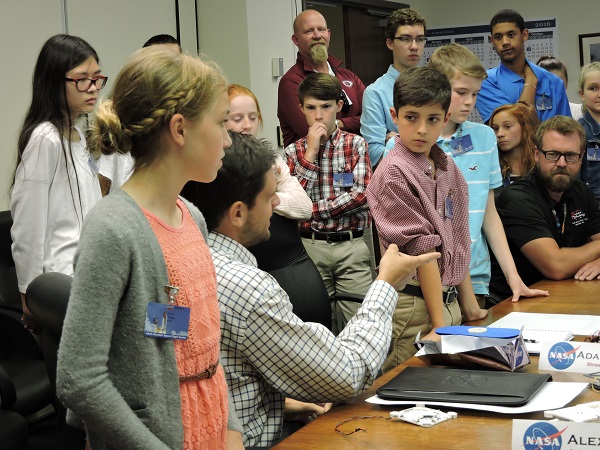
Robertsville Middle School students meet with NASA engineers at the Marshall Space Flight Center in Huntsville, Alabama, on Thursday, May 19, 2016. The small cube satellites that the students created were 1U (1 cube unit). This is an actual 6U (the size of 2×3 of the 1Us) cube satellite that is used to carry payloads in space. (Submitted photo via Oak Ridge Schools)
Most middle school students, when planning a trip to the U.S. Space and Rocket Center in Huntsville, Alabama, are thinking of IMAX theater screenings, artifacts, and experiencing the physics of astronaut training in simulators such as the Space Shot and G-Force.
But what if these learners were given a real-life challenge that NASA engineers face on a daily basis, and asked to solve problems generally relegated to the top minds in the industry? What if those same young scholars were given the opportunity to then present their thought processes and design challenges to NASA engineers for a critical review?
This is the incredible experience Robertsville Middle School Ram Time participants were given in Todd Livesay’s enrichment course, a press release said. It is a part of the Response to Instruction and Intervention, or RTI2, model introduced this year in Oak Ridge middle schools, which provides rich opportunities for students who are exceeding grade level expectations in their core courses.
When determining a course for the new curriculum for this enrichment course, Todd Livesay began conversations with a fellow Oak Ridge High School graduate, Patrick Hull, who now works for Marshall Space Flight Center in Huntsville, Alabama. Hull explained to Livesay the NASA CubeSat Launch Initiative, or CSLI, which provides opportunities for small satellite cubes to fly as auxiliary payloads on previously planned missions.
The CSLI program allows students to participate in CubeSat investigations that address research in science, technology, engineering, and math, or STEM, education that is consistent with NASA’s Strategic Plan. CSLI also provides educational opportunities that attract and retain students, teachers, and faculty in STEM disciplines. This strengthens the nation’s future workforce and promotes innovative partnerships between NASA and other U.S. industries, the press release said.
The CubeSat Launch Initiative provides access to a low-cost pathway for conducting research, deploying these small payloads in a ride-share format. Since its inception in 2010, the initiative has selected and launched more than 46 student-created CubeSats. These miniature satellites were chosen from responses to public announcements on NASA’s CubeSat Launch Initiative.
NASA will announce another call for proposals in mid-August 2016, possibly allowing Oak Ridge students an extension of the learning they had with their initial project this year, the press release said.
For the inaugural problem/project-based learning activity, Livesay’s students were challenged to create a small cube satellite with a lever-operated door that would deploy in space to release the contents of the cube. Students designed and created prototypes using AutoCAD Inventor as their software and Makerbot 3D printers as their hardware.
Their printed designs provided learning about which products and shapes provide the best stability. Students reported that the triangle is the optimal shape to incorporate in the design to create a stable and lightweight form. They emphasized proportionality, and the importance of the use of the Pythagorean Theorem.
Participants programmed the lever using Arduino boards and powered them with servo motors.

Robertsville Middle School students and Oak Ridge Schools Superintendent Bruce Borchers, center background, meet with NASA engineers at the Marshall Space Flight Center in Huntsville, Alabama, on Thursday, May 19, 2016. (Submitted photo via Oak Ridge Schools)
Students engaged in lively presentations emphasizing the use of all of these technologies and participated in subsequent discussions with the NASA engineers at Marshall for two early morning workday hours on Thursday, May 19. The engineers lauded the learners for admitting mistakes, asking questions, and persisting in finding answers. They engaged in a rigorous critique of the process and work of the students, giving them a taste of the necessity for inquiry, invention, perseverance, and absolute precision, the press release said.
An overarching theme of the panel’s critique was for the group to focus next on having a guiding question, a crystal clear end goal—in their words, a “shiny object” to find; and to consider adding a hinge to the door to eliminate the excess “space junk” that will be created when it ejects and floats away.
Susan Currie, education specialist from the Marshall Space Flight Center, wrote to Hull in response to the RMS visit saying: “Wow! If that group doesn’t inspire you, nothing will! I was blown away with the level of expertise and professionalism shown by the Oak Ridge students.”
At the end of the experience, Livesay’s class wrote letters of thanks back to their panel of experts. They expressed their gratitude, reflecting that even with the intrigue of space simulations and IMAX theater experiences, their favorite part was the two-hour interaction with experts who work on a daily basis to solve the problems they have been trying to solve over the past year in their favorite new Ram Time enrichment class.
This press release was submitted by Holly Cross of Oak Ridge Schools.
Copyright 2016 Oak Ridge Today. All rights reserved. This material may not be published, broadcast, rewritten, or redistributed.
Leave a Reply